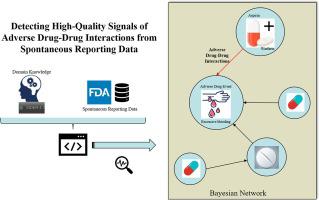Journal of Biomedical informatics ( IF 4.0 ) Pub Date : 2020-10-24 , DOI: 10.1016/j.jbi.2020.103603 Chen Zhan 1 , Elizabeth Roughead 2 , Lin Liu 1 , Nicole Pratt 2 , Jiuyong Li 1

|
As a medicine safety issue, Drug-Drug Interaction (DDI) may become an unexpected threat for causing Adverse Drug Events (ADEs). There is a growing demand for computational methods to efficiently and effectively analyse large-scale data to detect signals of Adverse Drug-drug Interactions (ADDIs). In this paper, we aim to detect high-quality signals of ADDIs which are non-spurious and non-redundant. We propose a new method which employs the framework of Bayesian network to infer the direct associations between the target ADE and medicines, and uses domain knowledge to facilitate the learning of Bayesian network structures. To improve efficiency and avoid redundancy, we design a level-wise algorithm with pruning strategy to search for high-quality ADDI signals. We have applied the proposed method to the United States Food and Drug Administration’s (FDA) Adverse Event Reporting System (FAERS) data. The result shows that 54.45% of detected signals are verified as known DDIs and 10.89% were evaluated as high-quality ADDI signals, demonstrating that the proposed method could be a promising tool for ADDI signal detection.
中文翻译:

从自发报告数据中检测不良药物相互作用的高质量信号
作为药品安全问题,药品相互作用(DDI)可能会成为导致不良药品事件(ADE)的意外威胁。对有效地和有效地分析大规模数据以检测不良药物-药物相互作用(ADDI)信号的计算方法的需求日益增长。在本文中,我们旨在检测非伪造和非冗余的高质量ADDI信号。我们提出了一种新方法,该方法采用贝叶斯网络框架来推断目标ADE与药物之间的直接关联,并使用领域知识来促进贝叶斯网络结构的学习。为了提高效率并避免冗余,我们设计了一种具有修剪策略的逐级算法来搜索高质量的ADDI信号。我们已将建议的方法应用于美国食品和药物管理局(FDA)的不良事件报告系统(FAERS)数据。结果表明,检测到的信号中有54.45%被验证为已知DDI,10.89%被评估为高质量ADDI信号,表明该方法可能是有前途的ADDI信号检测工具。











































 京公网安备 11010802027423号
京公网安备 11010802027423号